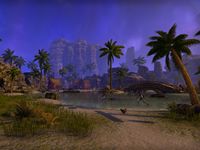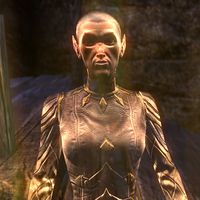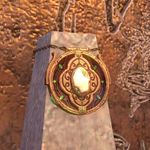Lore:Baan Dar
This article is about the god. For the planet, see Five Finger Dance.
- "Of the Dark Avenging Blade on the Wings of Night that make no sound. The Patron Saint of the Lone Wolf. The Thousand Eyes and Ears, the Hundred Arms direspectful of Time or Distance. Undying, Master of Disguise, Man of a Thousand Faces, Shapes and Sizes, Gentle, Rough-Edged, Gay, Stern. All the Mystery of the "Man Unknown and Undying"... not a single man nor God at all, but a string of seeds sown upon the land and left to grow into a forest." — Excerpt from The First Scroll of Baan Dar, transcribed by Arkan the Gifted (2E 24)
Baan Dar (known as the Bandit God, the Man of a Thousand Faces,[1] or the Pariah)[2] is the trickster spirit that is worshipped by the Khajiit of Elsweyr, but is known to have influence in places such as Valenwood.[3] In his Khajiiti aspect, the Pariah manifests as the cleverness or desperate genius of the long-suffering Khajiit, outplaying their fellow mortals, the humans and the elves. The nature of Baan Dar is a topic of speculation by scholars across the continent, believed by some to be more than an entity of tricks, but a powerful force that shapes the land and lives of the people in its wake, for the better. Baan Dar's name has been used liberally through the provinces; it has been used by the traveling merchant tribe, the Baandari Pedlars, while the criminal malcontent often refer to themselves in groups as the Baan Dars or the Bandits.[1] His domain is known as the Five Fingers Dance.
Further Information[edit]
The name of Baan Dar has untraceable origins. It is a name that has been used widely, losing the meaning it once held. Thieves used it to mask their identity while others take the name to enact the will of the Pariah himself. The name has even turned to superstition to scare young children, carry the hidden purpose of inspiring those to take arms and fight back. By now, the name of Baan Dar is used by a series of people, to act in what they believe is right, to use that as inspiration for what may confront them, and eventually, pass that on to the next generation.[1]
To the Khajiit, Baan Dar is a way of life, a symbol of rising to the challenge and defeating your oppressors. But because of its wide usage, to the Bosmer of Valenwood, he is only seen as a god of archery,[4] and patron of thieves and beggars,[5] but a sentiment that is still accepted by the Khajiit. Both races often meet in the ruins of Thormar to partake in Baan Dar's boast, a festival of pranks played between teams of Khajiit and Wood Elves, so that they may be granted access to the Bandit God's realm, the Five Fingers Dance.[6] However, to the other races of Tamriel, such as the Bretons, Baan Dar is a symbol of sneak-thieves and living legends.[5]
To the Bretons, Baan Dar is known as "the Bandit",[7] and is noted to be a considerable force within the lands of High Rock.[1] He is featured in the historical-fiction novel, King Edward, Queen Aliera praises him along with other gods for bringing her husband Moraelyn and son Edward to her safely.[7] Baan Dar is known to be revered by the Thieves Guild branch in the Iliac Bay.[8]
The Scrolls of Baan Dar[edit]
- For the full-story, see: The First Scroll of Baan Dar
The writer of the scrolls was mortally wounded by an arrow and wrote his experiences with Baan Dar with his dying breath in the caverns near Lake Vread. At 12 years old, they survived a slaver raid near the provincial border, leaving them an orphan. They survived as a thief in the backstreets of their hometown, but were often viciously tormented by bullies. After a confrontation that left them brutally beaten, the young child and the group of bullies were approached by Baan Dar, clad in a shadowy cloak and chainmail. The figure's fast reflexes had quickly dispatched the tormentor and gave them a meal. The child profusely thank him and asked how they can repay the favor, to which Baan Dar gave them a single response. "The proper way to repay a favor, is not to. Pass it on instead." Since then, the figure made the child their apprentice, teaching them the ways of defense, the harsh reality of the world, to live independently, and to think strategically with their worldly experience garnered from across the provinces. Within a year, the child disembarked to shape their own destiny, beginning the cycle all over again.[1]
These scrolls were translated and transcribed by a scribe of Daggerfall, Arkan the Gifted, who came to the same conclusion, much like the writer that Baan Dar is more than just a single entity, but a driving force to fight for what is right and to pass that knowledge to those that need it.[1] He went on to transcribe the other scrolls, but while the second one's whereabouts are unknown, the third scroll is one of the rarest pieces of literature in Tamriel. One is kept in the Library of Dusk, in Coldharbour. This third scroll details the thief god stealing Vivec's 37th Sermon from him before it was written.[9]
Artifacts[edit]
Eye of Baan Dar[edit]
The Eye of Baan Dar is a radish-sized hunk of moonstone with cultural significance to the Baandari clan. It was taken from the clan by Saint Vorys the Immolant during his conquest of Anequina, and served as the centerpiece for the Talisman of Saint Vorys. Vorys was under the impression that the stone possessed secret magical power, and spent the rest of his days attempting to unravel its secrets. For centuries, Telvanni mages of sufficient rank followed in his footsteps, attempting to exert their will over the stone and unravel its mysteries. However, their efforts were in vain: the stone had no magical properties, as it was simply an impressive hunk of unenchanted moonstone. Its only true significance was symbolic: the Eye of Baan Dar was a token traded between Baandari clans in Elsweyr. According to tradition, the Eye's holder may ask for any item or favor within reason, and the receiver must provide. The stone itself has very little value: it is a symbol of indulgence and trading in good faith.
Wand of Fowlfire[edit]
The Wand of Fowlfire is a wand artifact and a sacred relic of Baan Dar. It serves as a ceremonial tool reserved for special occasions. With its ability to emit powerful roasting effects, its primary purpose is to cook food for grand feasts in the god's honor. However, its misuse has tragically resulted in the deaths of some followers who failed to point the far end of the wand away from themselves. Despite these risks, it is renowned for its ability to perfectly cook chickens. Chickens subjected to the effects of the artifact were magically baked, transforming into delicious magically baked chicken meals.
See Also[edit]
Books[edit]
- Baan Dar and His Boast — A note advertising Baan Dar's Boast
- The First Scroll of Baan Dar by Arkan — A book about the true Baan Dar, God and Man
- On Those Who Know Baan Dar by Ak'an — Notes on the nature of the Khajiiti Bandit God
- Varieties of Faith: The Khajiit by Brother Mikhael Karkuxor of the Imperial College — A summary of the Khajiiti pantheon
- Varieties of Faith: The Wood Elves by Brother Mikhael Karkuxor of the Imperial College — A summary of the Bosmeri pantheon
Notes[edit]
- In the Daggerfall Preview, the first of three demos for The Elder Scrolls II: Daggerfall, there is a list of gods in the character creation, and among these is "Bajdit", the Bandit God. This name appears to be an early version of Baan Dar's name, which is further supported by The First Scroll of Bajdit, an almost exact copy of the First Scroll of Baan Dar lorebook.
- The Bandit God is also associated with two factions in the Daggerfall Preview, both are called the "Brotherhood of Bandit" and the "Wharf Rats."
- Another entity whose name is similar to Baan Dar appears in the final release of Daggerfall; shrines to Bandi can be found in the wilderness.
- In King Edward, Part 2 Moraelyn thanks several gods, including "the Bandit".
- Michael Kirkbride's Cosmology labels Baan Dar as the "Rogue Plane". It is unknown whether this is an error, or is intending to imply a direct relationship between Baan Dar and Baar Dau.
- Baan Dar's daughter was known to manifest as a female Mer, known as Aniel.[10]
References[edit]
- ^ a b c d e f The First Scroll of Baan Dar — Arkan
- ^ Varieties of Faith: The Khajiit — Brother Mikhael Karkuxor of the Imperial College
- ^ Varieties of Faith: The Wood Elves — Brother Mikhael Karkuxor of the Imperial College
- ^ The Improved Emperor's Guide to Tamriel: Valenwood — Flaccus Terentius, 2E 581
- ^ a b On Those Who Know Baan Dar — Ak'an
- ^ Baan Dar and His Boast
- ^ a b King Edward, Part 2 — Anonymous
- ^ Parchment mentioning him during A Noble's Debts in Daggerfall
- ^ The Library of Dusk: Rare Books
- ^ Aniel's dialogue in ESO
|
|||||||||||
|
||||||||||||||||||||||||||||||||


